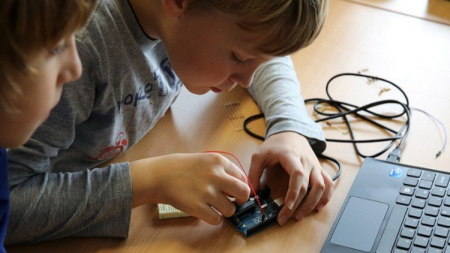Simplilearn Arduino using Arduino IDE LabVIEW MATLAB
- 21.11.2021
- 151

MP4 | Video: h264, 1280x720 | Audio: AAC, 44.1 KHz, 2 Ch
Genre: eLearning | Language: English | Duration: 37 lectures (3 hour, 14 mins) | Size: 1.91 GB
Arduino for an Engineer
What you'll learn
Understand what the Arduino UNO is
Understand analog and digital inputs and outputs
Write simple Arduino sketches that can get sensor reading
Understand what Arduino programming is, its basic concepts, structures, and keywords
Design circuits and write code for your own project
Requirements
Be able to use a computer (Windows and Mac covered in the course, Arduino will also work on Linux)
An Arduino Uno
Description
Arduino is an open-source computer hardware/software platform for building digital devices and interactive objects that can sense and control the physical world around them. In this class you will learn how the Arduino platform works in terms of the physical board and libraries and the IDE (integrated development environment).
Upon completing this course, you will be able to:
1. Outline the composition of the Arduino development board
2. Describe what it means to program the board's firmware
3. Read board schematics
4. Install Arduino IDE
5. Acquire digital/analog/PWM signal
6. Generate digital/analog/PWM signal
7. Pullup register/Pulldown register
8. Touch sensor interfacing
9. Acquire digital signal and generate digital signal.
10. Arduino Programming using LabVIEW.
11. Arduino Programming using MATLAB.
A versatile tool for prototyping, playing and making
Arduino is both a hardware platform and a programming language. By learning how to build circuits and code, you can add a new level of interactivity to your projects, prototype potential products, and gain new skills (while hopefully having fun).
The Arduino programming language is based on a combination of C and C++. With an understanding of these coding fundamentals, you will be able to learn new languages more easily, such as Java, Python, jаvascript, C#, and Swift, which are in high demand in the job market.
Arduino senses the environment by receiving inputs from add-on devices such as sensors and can control the world around it by adjusting lights, motors, and other actuators. In this class, you will learn how and when to use the diverse types of sensors and how to connect them to the Arduino. Since the external world uses continuous or analog signals and the hardware is digital you will learn how these signals are converted back-and-forth and how this must be considered as you program your device. You'll also learn about the use of Arduino-specific shields and the shields software libraries to interface with the real world. Please note that this course does not include discussion forums.
Who this course is for:
Makers, crafters, and students who are interested in adding electronics and interactivity to their projects
https://uploadgig.com/file/download/f015CfF8d9755ce2/pOrcAd6B_.Simplilear.part2.rar
https://uploadgig.com/file/download/B83cB5fe00d2122A/pOrcAd6B_.Simplilear.part1.rar
or
https://rapidgator.net/file/7bd7ef886e20b5c756593b6a4f229b23/pOrcAd6B_.Simplilear.part2.rar.html
https://rapidgator.net/file/5167afec47af5e95ec4d6042c5f72f7f/pOrcAd6B_.Simplilear.part1.rar.html
or
https://hot4share.com/byyckfsqtucn/pOrcAd6B_.Simplilear.part2.rar.html
https://hot4share.com/u1dmpn20x2pd/pOrcAd6B_.Simplilear.part1.rar.html